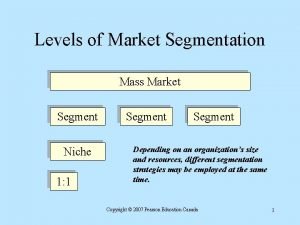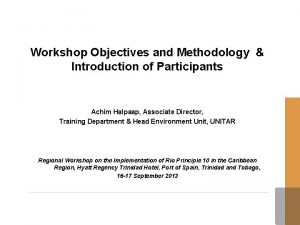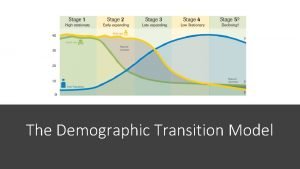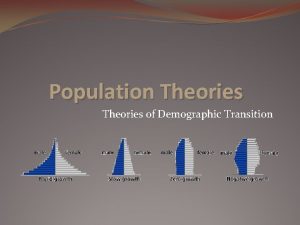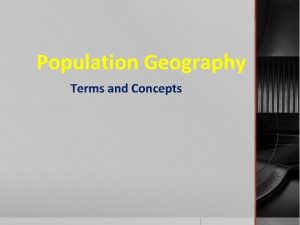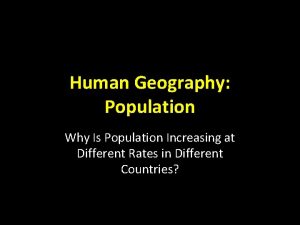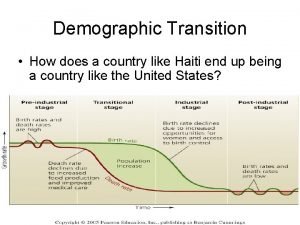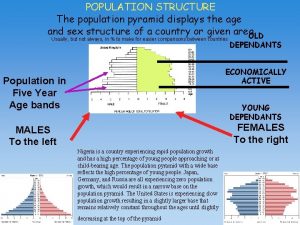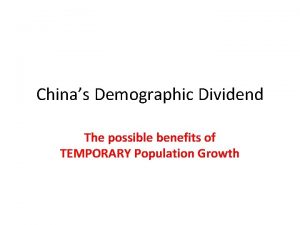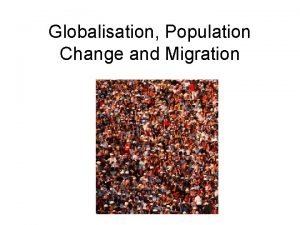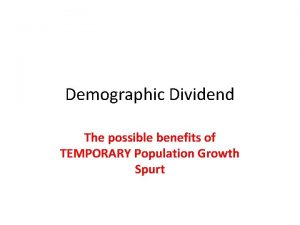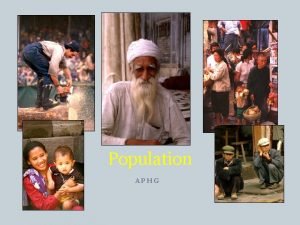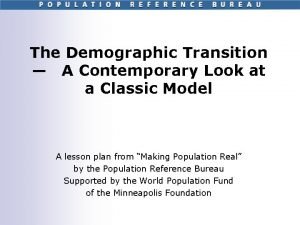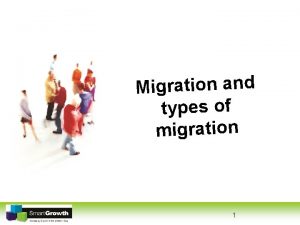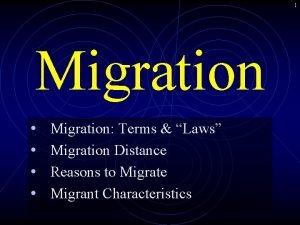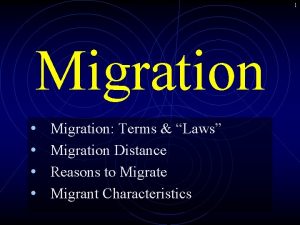Workshop on Demographic Analysis and Evaluation Migration Introduction


















































- Slides: 50

Workshop on Demographic Analysis and Evaluation

Migration

Introduction Migration is often the least important component of population change, but for some countries migration may be as important as, or more important than, fertility and mortality in determining population change. These are countries with substantial circular labor migration flows (whether as sending or host country) or longer term flows. They may be destination countries like the U. S. , major migrant-origin countries like Iran, or both sending and receiving countries, like Thailand. 3

Introduction In this part of the workshop we look at sources and measurement of net migration, the fourth component needed for cohort-component projection. We will cover: § Sources of international migration data § Indirect and direct measurement of international migration. We will touch upon: § Sources of internal migration data § Indirect and direct measurement of internal migration. 4

Introduction This discussion includes material introduced in chapter 5 of the Census Bureau’s Population Analysis with Microcomputers as well as from the United Nations’ report Preparing Migration Data for Subnational Population Projections. 5

Why Migration Matters § For countries with substantial net international migration, the size, composition, growth and distribution of population is affected by that migration. § Future population growth and characteristics are also affected. § For subnational projections, migration plays an especially important role in defining future population distribution. 6

Measuring International Migration data are available from censuses and surveys (from questions about birthplace, residence at a previous date, or place of previous residence and duration of residence), arrivals and departures data published in statistical yearbooks, from published immigration or labor statistics from other countries, or from dedicated statistical databases, and, for some countries, from population registers. 7

Measuring Internal Migration data are available from censuses and surveys (from questions about birthplace, residence at a previous date, or place of previous residence and duration of residence). 8

Types of Migration Data for Direct Estimation Type Description Questions Lifetime Change of residence since birth Place of birth and place of current residence only Strengths and weaknesses Migration during Change of Where was past 12 months residence during person living 12 or another fixed past year months ago? reference period Migration during past 5 years Change of Where was residence during person living 5 past 5 years ago? 9

Types of Migration Data for Direct Estimation Type Description Questions Duration of residence Focus on latest migration only 1. How long lived in current residence, and 2. Previous residence Strengths and weaknesses 10

Types of Migration Data for Direct Estimation Type Description Questions Full migration history Collection of data for all migration events, including timing, locational change, and other characteristics of migrant and places at move Questions about dates, origin and destination, and migrant and place characteristics for each move Strengths and weaknesses 11

Types of Migration Data for Direct Estimation Type Strengths and weaknesses Lifetime Provides some idea of flows, but truly useful only with multiple censuses and then only by calculating differences in cohort or subpopulation size after adjusting for mortality and underenumeration. Not a good substitute for migration measured using a question on a fixed reference period. 12

Types of Migration Data for Direct Estimation Type Strengths and weaknesses Migration during past 12 months Excellent measure but migration may be exaggerated by recent events. Migration during past 5 years Excellent measure providing picture of movement over past 5 years. A major weakness of this and other measures is its asymmetry for measuring international migration. Out-migrants are typically not counted well. 13

Types of Migration Data for Direct Estimation Type Strengths and weaknesses Duration of residence Portrait of migration flows distorted by return and multiple movers. 14

Types of Migration Data for Direct Estimation Type Strengths and weaknesses Complete migration history Best picture of migration, including all types of movement. However, the number of questions required is suitable for surveys rather than censuses. Amount of data generated may be unwieldy. 15

Direct Estimation from Statistics on Lifetime Migration: International Migration Example Statistics on change of residence since birth are useful in the direct estimation of international migration. Migration from country X, for instance, can be assessed if one knows the level of “foreign born” from country X counted in country Y. Such data on the foreign born can indicate lifetime migration for some groups.

Direct Estimation from Statistics on Lifetime Migration: International Migration Example Total and Indian Foreign-born Populations in the United States, 1960 to 2008 India share of India-born Foreign-born 12, 296 0. 10% Year 1960 Foreign-born 9, 738, 091 Ranking 42 1970 9, 619, 302 51, 000 0. 50% 30 1980 14, 079, 906 206, 087 1. 50% 16 1990 19, 797, 316 450, 406 2. 30% 12 2000 31, 107, 889 1, 022, 552 3. 30% 4 2008 37, 960, 773 1, 622, 522 4. 30% 3

Direct Estimation from Statistics on Lifetime Migration: International Migration Example Data on the foreign born may be most helpful from countries with (1) reliable data, (2) larger numbers of foreign born, and (3) known migrant ties to the sending country. http: //www. migrationinformation. org/pdf/cities_12. 06_fig 2. pdf

Direct Estimation from a Question on Residence 5 Years before a Census: Internal Migration Example 19

Commentary: The Duration-of-Residence Problem Data on the place of previous residence have only limited value in themselves because they do not provide information on the time of in-migration. Therefore, when the topic is investigated, the duration of residence should also be investigated, if at all possible, so that the data can be cross-classified. – United Nations Statistical Division, Principles and Recommendations for Population and Housing Censuses, Revision 1 (ST/ESA/STAT/SER. M/67/Rev. 1), pp. 62 -63. 20

Commentary: The Duration-of-Residence Problem Many censuses do not have a question on place of residence at a fixed prior date but ask for previous place of residence and duration of residence in the current place. Although it has been argued that these two questions, when taken together, provide more useful information than place of residence at a fixed prior date, this is clearly not the case for the estimation of migration rates to use in projections. 21

Commentary: The Duration-of-Residence Problem As Corgeau (1988) points out, these questions are only useful in estimating migration rates if it is assumed that each person made only one move during the period of interest or if some estimate of multiple moves can be used to adjust the data. – United Nations, Preparing Migration Data for Subnational Population Projections (ST/ESA/SER. A/127), p. 10. [Speare 1992] Issues: A B C A B A 22

Commentary: The Duration-of-Residence Problem • From Speare (1992: 10): • “Obtaining an approximate measure of migration from these questions requires that the data be tabulated in a large three-way table (or in a series of component tables) showing place of current residence by place of previous residence by duration of residence. Alternatively, the total numbers of in-migrants and out -migrants for each province can be tabulated by duration of residence…" 23

Commentary: The Duration-of-Residence Problem From Speare: “… In preparing these data for projections, separate estimates of in-migration and out-migration are obtained for each region. These estimates are then checked to see that the total number of in-migrants equals the total number of out-migrants or that the difference equals the assumed level of net international migration. If they are not equal, adjustments need to be made. . . ” 24

Commentary: The Duration-of-Residence Problem A B C A B A Speare: “Both of these cases create a problem when migration is estimated from a cross-tabulation of previous place of residence and duration of residence. Those that moved from A to B to C will be recorded as having moved from B to C, and those that moved from A to B to A will be recorded as having moved from B to A. In both cases, however, they were actually at place A at the beginning of the projection period. " 25

Commentary: The Duration-of-Residence Problem A B C A B A “… If no adjustment is made for repeated movement during the five-year period, these two cases would be erroneously subtracted from the population at place B and not from place A. If there were many such persons, the population at place A would be projected to be larger and that at place B smaller than should be the case. " 26

Commentary: The Duration-of-Residence Problem The solution, from Speare, using Indonesia as example: 1. Cross tabulation of in-migration flows by province of destination, province of origin, and duration of residence (Speare’s table 3 (Speare 3 -5. xls)) 2. For each destination, estimate the proportion of inmigrants who are return migrants and use that proportion to adjust apparent in-migration volume (Speare, tables 4, 5) 3. Repeat for out-migration flows. 4. Force internal in-migration and out-migration to sum to zero. 27

Commentary: The Duration-of-Residence Problem Additional issues and needed adjustments (Speare 1992: 12): 1. Underreporting of migration (including migrants of short duration) 2. Misreporting of duration of residence (including duration-heaping) 28

Approaches for Indirect Estimation Approaches involve calculating the difference between “expected” and actual population growth: § Life table survival ratio method § Forward survival § Reverse survival § Composite forward and reverse survival § Census survival ratio method (CSRMIG. xls) § Composite life table and census survival method § Residual technique using cohort-component population projections 29

Approaches for Indirect Estimation Approaches involve calculating the difference between “expected” and actual population growth: } § Life table survival ratio method § Forward survival § Reverse survival § Composite forward and reverse survival § Census survival ratio method (CSRMIG. xls) § Composite life table and census survival method } § Residual technique using cohort-component population projections Usually applied in internal migration estimation Usually applied in international migration estimation 30

Indirect Estimation: Life Table Survival Ratio Method Forward survival First census P 0 -4 P 5 -9. . . P 75 -79 P 80+ * Life table survival ratios 5 Sx, x+10 i. e. , 5 Lx+10 /5 Lx = Expected population P 10 -14 P 15 -19. . . P 80+ at second census - Second census P 10 -14 P 15 -19. . . P 80+ = Implied migrants P 10 -14 P 15 -19. . . P 80+ , ages at second census 31

Indirect Estimation: Life Table Survival Ratio Method Reverse survival Second census P 10 -14 P 15 -19. . . P 80+ * Life table survival ratios 1/(5 Sx) i. e. , 5 Lx /5 Lx+10 = Expected population P 0 -4 P 5 -9. . . P 70+ at first census - First census P 0 -4 P 5 -9. . . P 75 -79 P 70+ = Implied migrants P 0 -4 P 5 -9. . . P 70+ , ages at first census 32

Indirect Estimation: Life Table Survival Ratio Method Composite of forward and reverse survival Implied migrants P 0 -4 P 5 -9. . . P 70+ , ages at first census + Implied migrants P 10 -14 P 15 -19. . . P 80+ , ages at second census = Implied migrants Px ages at midintercensal period 2 33

Indirect Estimation: Census Survival Ratio Method First census P 0 -4 P 5 -9. . . P 75 -79 P 80+ * Census survival ratios 5 CSx, x+10 i. e. , national 5 Px+10 /5 Px Expected population P 10 -14 P 15 -19. . . P 80+ at second census = - Expected population P 10 -14 P 15 -19. . . P 80+ at second census Second census P 10 -14 P 15 -19. . . P 80+ Note: Reverse survival is also possible with this method = Implied migrants P 10 -14 P 15 -19. . . P 80+ , ages at second census Spreadsheet: CSRMIG. xls 34

Indirect Estimation: Composite Life Table and Census Survival Ratio Method First census P 0 -4 P 5 -9. . . P 75 -79 P 80+ * Census survival ratios 5 CSx, x+10 i. e. , national 5 Px+10 / 5 Px * Expected population P 10 -14 P 15 -19. . . P 80+ at second census Ratios of regional to national life table survival ratios 5 Sx , r / 5 Sx, N - Second census P 10 -14 P 15 -19. . . P 80+ = = Expected population P 10 -14 P 15 -19. . . P 80+ at second census Implied migrants P 10 -14 P 15 -19. . . P 80+ , ages at second census 35

Indirect Estimation: Residual Technique using Cohort -component Population Projections Net international migration can also be estimated with the more complex technique of comparing “expected” growth due to natural increase, as projected with the cohortcomponent method, with actual overall growth indicated by a census (or survey). The Census Bureau’s RUPCEN. xls spreadsheet and a RUP projection program will do the calculations. 36

Indirect Estimation: Residual Technique using Cohort -component Population Projections Net international migration estimated as a residual. Spreadsheet: RUPCEN. xls 37

Indirect Estimation: Residual Technique using Cohort -component Population Projections Net international migration estimated as a residual. Spreadsheet: RUPCEN. xls 38

Indirect Estimation: Residual Technique using Cohort -component Population Projections 1. From PASEXNew. xls, access RUPCEN. xls 2. Save file in desired location Spreadsheet: RUPCEN. xls

Indirect Estimation: Residual Technique using Cohort -component Population Projections 3. Enter RUP name and location 6. Press extract button 4. Enter census reference date 5. Enter census data Spreadsheet: RUPCEN. xls

Indirect Estimation: Residual Technique using Cohort -component Population Projections View graphs, for male and female populations. Spreadsheet: RUPCEN. xls

Indirect Estimation: Residual Technique using Cohort -component Population Projections View graphs, for male and female populations, as well as percent net census error by sex. Spreadsheet: RUPCEN. xls

Indirect Estimation: Residual Technique using Cohort -component Population Projections In this example, the graphs suggest male migration only. Spreadsheet: RUPCEN. xls

Indirect Estimation: Residual Technique using Cohort -component Population Projections Examine the numerical data, in the Male, Female, and Both sexes spreadsheet tabs… Notice implied levels of male migration by age group. Spreadsheet: RUPCEN. xls

Indirect Estimation: Residual Technique using Cohort -component Population Projections If the difference between projection and RUP can be attributed to migration (for at least some age groups) AND If the census is 5 years following your base year (or any multiple of 5 years following your base year) average annual estimates can be developed… Spreadsheet: RUPCEN. xls

Indirect Estimation: Residual Technique using Cohort -component Population Projections In our example, the base year of projection is 2000; the census is 10 years after in 2010. A residual estimate can then be developed (in this example for males only) by “shifting back” cohorts 5 years… Spreadsheet: RUPCEN. xls

Indirect Estimation: Residual Technique using Cohort -component Population Projections “Shifting back” cohorts, to the next younger age places the net migration estimate in the midintercensal period (2005). Spreadsheet: RUPCEN. xls

Indirect Estimation: Residual Technique using Cohort -component Population Projections After “shifting back, ” to capture the proper time reference, the values can be annualized (again only in a 10 -year intercensal period) by dividing them by 10. Spreadsheet: RUPCEN. xls

Indirect Estimation: Residual Technique using Cohort -component Population Projections Since net error for other age groups is likely due to census undercount, assume zero net annual migration for them, accordingly. Spreadsheet: RUPCEN. xls

References Arriaga, Eduardo et al. 1994. Population Analysis with Microcomputers. Washington, D. C. : U. S. Census Bureau, chapter V. United Nations. 1992. Preparing Migration Data for Subnational Population Projections. Department of International Economic and Social Affairs, ST/ESA/SER. A/127. New York. 50
 Mass segment
Mass segment Demographic psychographic and geographic
Demographic psychographic and geographic Indebtedness and deregulation in hrm
Indebtedness and deregulation in hrm The migration of darkness analysis
The migration of darkness analysis Introduction to monitoring and evaluation
Introduction to monitoring and evaluation Sheet metal workshop introduction
Sheet metal workshop introduction Introduction of participants in training
Introduction of participants in training Introduction of participants in a workshop
Introduction of participants in a workshop Population distribution
Population distribution Uk demographic transition model
Uk demographic transition model Demographic transition stages
Demographic transition stages Demographic segmentation of tesla
Demographic segmentation of tesla Theory of demographic transition
Theory of demographic transition Demographic momentum ap human geography definition
Demographic momentum ap human geography definition Demographic transition theory
Demographic transition theory Demographic stochasticity
Demographic stochasticity Demographic transition model ap human geography
Demographic transition model ap human geography Avoiding discrimination through causal reasoning
Avoiding discrimination through causal reasoning Population demography definition
Population demography definition Denmark demographic transition model
Denmark demographic transition model Warren thompson's demographic transition model
Warren thompson's demographic transition model Haiti demographic transition model
Haiti demographic transition model Demographic transition
Demographic transition Intermarket segmentation
Intermarket segmentation Rimland theroy
Rimland theroy Un demographic yearbook
Un demographic yearbook Demographic cohort
Demographic cohort Pringles target demographic
Pringles target demographic Population pyramid stage 1
Population pyramid stage 1 Demographic transition model worksheet
Demographic transition model worksheet Recent demographic changes in the uk
Recent demographic changes in the uk Demographic dividend china
Demographic dividend china Two big breaks in the demographic transition
Two big breaks in the demographic transition Demographic transition model song
Demographic transition model song Kathy lau
Kathy lau Difference between a sample and a population
Difference between a sample and a population Where are the holes in the ozone layer located
Where are the holes in the ozone layer located Demographic transition
Demographic transition Old woman
Old woman Demographic dimensions of consumer market
Demographic dimensions of consumer market Afghanistan dtm stage
Afghanistan dtm stage Demographic transition def
Demographic transition def Demographic momentum ap human geography
Demographic momentum ap human geography Biohacking market demographic
Biohacking market demographic Flows definition ap human geography unit 1
Flows definition ap human geography unit 1 Bts fan age demographic 2020
Bts fan age demographic 2020 Demographic transition model example
Demographic transition model example Demographic transition model
Demographic transition model Management of learning (mol)
Management of learning (mol) Italy population pyramid
Italy population pyramid Demographic imperative intercultural communication
Demographic imperative intercultural communication
